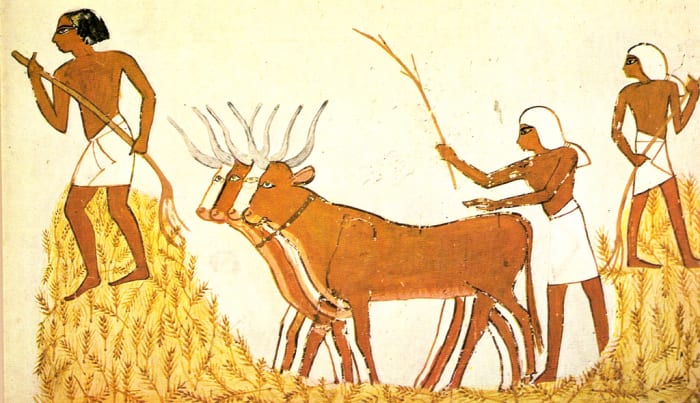8,000 Years Ago, 17 Women Reproduced for Every One Man

Threshing wheat in ancient Egypt. (Photo: Carlos E. Solivérez/Wikimedia Commons)
Once upon a time, 4,000 to 8,000 years after humanity invented agriculture, something very strange happened to human reproduction. Across the globe, for every 17 women who were reproducing, passing on genes that are still around today—only one man did the same.
"It wasn't like there was a mass death of males. They were there, so what were they doing?" asks Melissa Wilson Sayres, a computational biologist at Arizona State University, and a member of a group of scientists who uncovered this moment in prehistory by analyzing modern genes.
Another member of the research team, a biological anthropologist, hypothesizes that somehow, only a few men accumulated lots of wealth and power, leaving nothing for others. These men could then pass their wealth on to their sons, perpetuating this pattern of elitist reproductive success. Then, as more thousands of years passed, the numbers of men reproducing, compared to women, rose again. "Maybe more and more people started being successful," Wilson Sayres says. In more recent history, as a global average, about four or five women reproduced for every one man.
Physically driven natural selection shaped many human traits. Ethnic Africans and Europeans had to evolve to digest milk, for example, while most ethnic Tibetans have adaptations to deal with the lower oxygen levels at high altitudes. But if Wilson Sayres' team's hypothesis is correct, it would be one of the first instances that scientists have found of culture affecting human evolution.
The team uncovered this dip-and-rise in the male-to-female reproductive ratio by looking at DNA from more than 450 volunteers from seven world regions. Geneticists analyzed two parts of the DNA, Y-chromosome DNA and mitochondrial DNA. These don't make up a large portion of a person's genetics, but they're special because people inherit Y-chromosome DNA exclusively from their male ancestors and mitochondrial DNA exclusively from their female ancestors. By analyzing diversity in these parts, scientists are able to deduce the numbers of female and male ancestors a population has. It's always more female.
"It wasn't like there was a mass death of males. They were there, so what were they doing?"
So much for what our DNA can tell us. This study, published last week in the journal Genome Research, can't directly account for why the dip occurred. Instead, the team members tried to think through other explanations. "Like was there some sort of weird virus that only affected males across the whole globe, 8,000 years ago?" Wilson Sayres asks—a hypothesis the team found unlikely....MORE